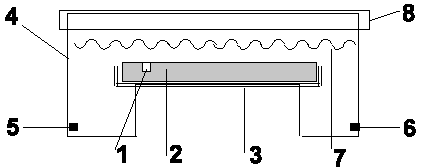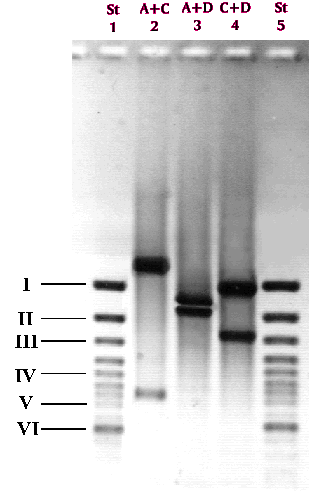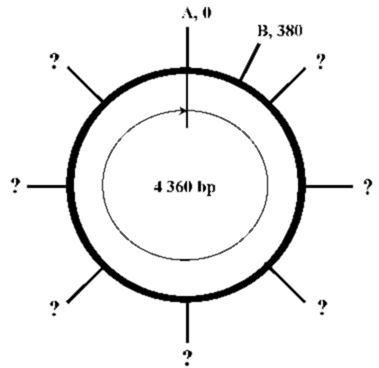
Latvia, 2002
Ministry of Education and Science
University of Latvia
Association of Biology Teachers
phone: +371-7034860, +371-7334125, Fax: +371-7223801, email: ulkoro@latnet.lv
 |
13th International Biology Olympiad
Latvia, 2002 Ministry of Education and Science
|
| 4 Kronvalda boulv., Riga LV-1586, LATVIA
phone: +371-7034860, +371-7334125, Fax: +371-7223801, email: ulkoro@latnet.lv | |
Length of the practical test - 60 minutes; 40 points
Task: Electrophoretic separation of plasmid pX DNA fragments in an agarose gel and construction of a restriction map of the pX plasmid.
The lab assistants will give 5 points for strict following the lab safety regulations and accurate sample loading:
A - wearing the lab gloves during laboratory experiment – 1 point ,
B - addressing the assistant before usage of the power supply and correct usage of UV transilluminator – 1 point ,
C - proper use of pipette – 1 point,
D - loading the whole amount of the sample in the well - 1 point ,
E - not damaging the gel – 1 point .
Note: One power supply is used by 3 - 4 – students, one UV transilluminator is used by 2 students!
![]() Please wear the gloves during laboratory experiment !
Please wear the gloves during laboratory experiment !
![]() Managing of power supplies is the priority of laboratory assistants !
Managing of power supplies is the priority of laboratory assistants !
Technical explanation
Theory
Electrophoresis is a widely used analytical method for separation of molecules by their charge, molecular weight and size. Frequently electrophoretical separation is performed in gel media where molecules with similar charges are separated according to their molecular weight and size. The substance, which forms the gel, has to be dissolved in the buffer solution.
Mapping of plasmid DNA
Plasmids are circular extrachromosomal double-stranded DNA molecules, which are found in many bacterial species. Restriction enzymes are nucleases, which cleave DNA at the sites where specific 4 – 6 nucleotide (base) pair (bp) sequences are found; e.g. enzyme called HaeIII cuts the double stranded DNA at sequence (site) GGCC, but enzyme called EcoRI cuts the double stranded DNA at sequence (site) GAATTC.
Plasmid DNA mapping is placing of the restriction enzyme cleavage sites relative to each other on the circular scheme of the plasmid molecule. For this purpose we have to determine the length of DNA fragments produced by cleavage of the plasmid with different restriction enzymes. Plasmid molecules can be cut by one or by multiple restriction enzymes simultaneously. DNA fragments produced at cutting migrate as compact bands, which can be visualised in the gel by staining with specific dyes. The distance, which DNA fragment migrates in the gel during electrophoresis (cm from the start point of the migration till the front edge of the fragment band), is inversely correlated to the logarithm of the length of the fragment as measured in bp. One of the most common gel substances for electrophoresis is agarose. Pores of the agarose gel are large enough for separation of molecules with molecular mass over 100 000 Da.
Equipment
Agarose gel electrophoresis tank
(4, Fig.1). contains two electrodes - cathode (5) and anode (6), respectively. Before electrophoresis the gel is overlaid with buffer solution (7). Samples, which contain the mixture of molecules to be analysed, are loaded in the wells (1), which are formed by special comb during the preparation of the gel (2) on the gel support (3). Before connecting to the power supply the electrophoresis tank is closed with a cover (8).

Fig 1. Electrophoresis tank with a gel.
Adjustable volume pipettes are used for handling of liquids (Fig.2).

Fig 2. Adjustable volume pipette.
Use of the pipette:
1. By turning of adjustment ring (3) and controlling the volume monitor (2) set the appropriate volume! In this experiment you need to handle two volumes – 5 µl and 10 µl. Correct setting of these volumes on the monitor is shown in Fig. 3.

Fig. 3. Correct setting of 5 µl and 10 µl volumes on the monitor of the pipette.
2. Place the yellow tip (1, Fig.2) on the shaft of the pipette.
![]() Do not handle liquid without a tip!
Do not handle liquid without a tip!
3. Press the button (4,Fig.2) smoothly to the first stop and put the tip in liquid (sample), (Fig.4,A).
4. Slowly release the button to aspirate the sample (Fig. 4 B).
5. Take the tip with the liquid to the target (other drop of liquid or well in the gel) and press the button until collected liquid is completely out of the tip (Fig. 4 C).

|
Take off the tip with your fingers |
Fig. 4. Steps of liquid handling.
|
6. Take out pipette from the liquid, release the button (Fig. 4 D) and displace the used tip in the trash, labelled as: |
 |
![]() For each solution or sample use a fresh tip!
For each solution or sample use a fresh tip!
You can make some trial pipetting attempts with one tip and buffer solution in the tank before starting to handle DNA samples.
Reagents and materials
To DNA samples fluorescent DNA dye Vistra Green in dilution of 1:10 000 is already added.
For all cleavages DNA of plasmid pX is used. The length of plasmid pX is 4 360 bp.
Experiment (first phase)
Sample loading
2. Add 5 µl of 2x GLB to each of cleaved plasmid DNA samples (B+C and B+D ) and load the mix (10 µl) on the gel (B+C in the well No.3 and B+D in the well No.4, respectively). |
Fig. 5. Sample loading. |
3. Close the cover of the electrophoresis unit. Call the assistant by raising the hand!
![]() Do not manage power supply; this is the priority of laboratory assistants !
Do not manage power supply; this is the priority of laboratory assistants !
Let the samples run for 20 min. Mind the time, otherwise you lose DNA fragments! Use this time to prepare the answers to the questions below!
Questions (first set, to be answered while the gel runs)
Q1. It is known that in the electrophoresis buffer with pH 8,0 DNA molecules are migrating from cathode to anode.
Give the answers by marking the appropriate boxes Q1 in the answer list.
- What is the charge of DNA molecules?
A . negative
B. neutral
C. positive
D. Impossible to determine
- Which of the mentioned components is the major determinant of the charge of DNA molecules?
E. purines
F. pyrimidines
G. deoxyriboses
H. phosphate groups
I. hydrogen bonds between the both DNA strands
J. No one of the mentioned
(2 points)
Q2. DNA fragment calculations
Given:
3 000; 2 000; 1 500; 1 200; 1 031; 900; 800; 700; 600; 500; 400; 300; 200; 100 (in bp)
Band of 500 bp fragments has elevated width (is darker) in respect to neighbour bands.
Bands of short DNA fragments (under 500 bp) may be weak or lost from the gel.
Estimate
Q2A. What is the size (bp) DNA fragments marked with the Roman numerals (I-VI) in the DNA size standard Lane 1, Fig.6.? Put the answers in the appropriate cells (I-VI) of the table Q2A in the answer list.
(3 points)
 |
Fig. 6. Electrophoretic separation of plasmid pX cleavage fragments.
Lanes are numbered under the gel, the wells are seen in the upper part. Lane 1 – DNA fragment length standard Lane 2 cleavage of plasmid pX with enzymes A + C Lane 3 cleavage of plasmid pX with enzymes A + D Lane 4 cleavage of plasmid pX with enzymes C + D Lane 5 – DNA fragment length standard |
Q2B. Plot the distance (cm) migrated by the DNA fragment length standard bands marked with Roman numerals in Fig.6 versus the length of DNA fragments (bp) as determined in your answer Q2A in the co-ordinates Q2B in your answer list. Make the graph using the plotted points
On the X-axis - distance from the well to the front (distant) edge of the band (cm); on the Y axis – length of the DNA fragments (bp).(4 points)
Q2C. Using the graph constructed in paragraph Q2B determine the size (bp) of DNA fragments presented in lanes 2, 3 and 4, Fig.6. Put the answers in the columns 2, 3 and 4 of the table Q2C in the answer list, corresponding the gel lanes 2, 3 and 4, respectively. (Allowed accuracy ±10% of exact value). (6 points)
Q2D. In the sample A+C (Lane 2, Fig.6) after mixing with gel loading buffer DNA concentration was 150 ng/µl (nanograms per microliter), 10 µl were loaded on the gel.
How much DNA (in ng) was loaded on the gel? Put the answers in the column 1 of the table Q2D in the answer list.
How much DNA (in ng) is contained in each of the bands in the lane 2, Fig.6 (A+C) (assuming that all the loaded DNA is distributed between the two bands)? Put the answers in the column 2 (for the band of the largest DNA fragment) and column 3 (for the band of the smallest DNA fragment) of the table Question 2D in the answer list. (Allowed accuracy ±10%). (6 points)
| If you still have time until the gel is ready, you can start considering the possible location of cutting sites for the restriction enzymes C and D in the plasmid map (Fig. 7). Use the results from the answer to Q2C!
|

Fig. 7 |
Experiment (second phase)
20 minutes after the beginning of electrophoresis the assistant will disconnect your electrophoresis tank from the power supply. Do not hesitate to remind the time to the lab assistant!
Thereafter:
![]() Do not switch on the UV transilluminator, while the protecting shield is open !
Do not switch on the UV transilluminator, while the protecting shield is open !
![]() Do not lift the protecting shield while the UV light is on !
Do not lift the protecting shield while the UV light is on !
Questions (second set, to be answered after the recording the fragment separation in the gel)
Q 4 A. Determine the approximate fragment length of cut DNA, comparing the position of the bands of samples with the bands of DNA size standard. Put the answers in the answer list; table Q4A, columns 3 and 4, corresponding the lanes 3 and 4, respectively. (Allowed accuracy ±20%). (4 points)
Q 4 B. Considering the analysis of the gel depicted in Fig.6 and the data obtained from your own gel, determine the approximate positions of the cutting sites of the enzymes C and D at the plasmid map (Q4B, answer list) by writing the letters (C, D) in appropriate boxes.(6 points)
| |||||
| |||||
| |||||
| Registration | |||||
| |||||
| Supports | |||||
| Results | |||||
|
Final Report
English version of tasks Russian version of tasks | |||||
| |||||
| Feedback | |||||
|
Monday October 18, 2004; 20:59
Main Frame | |||||